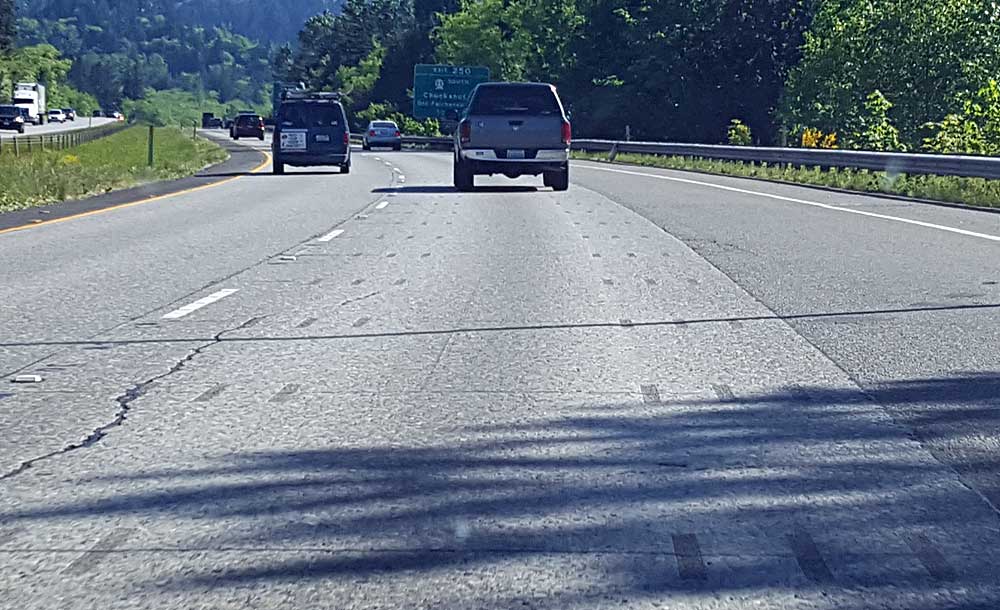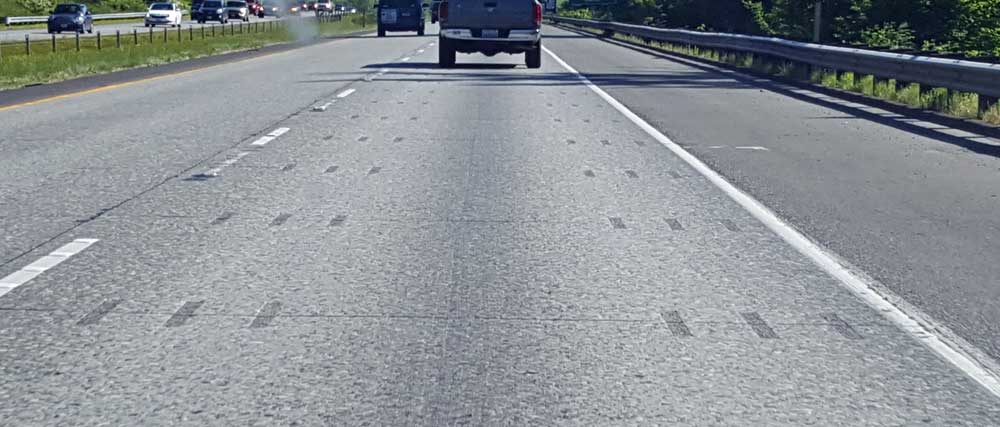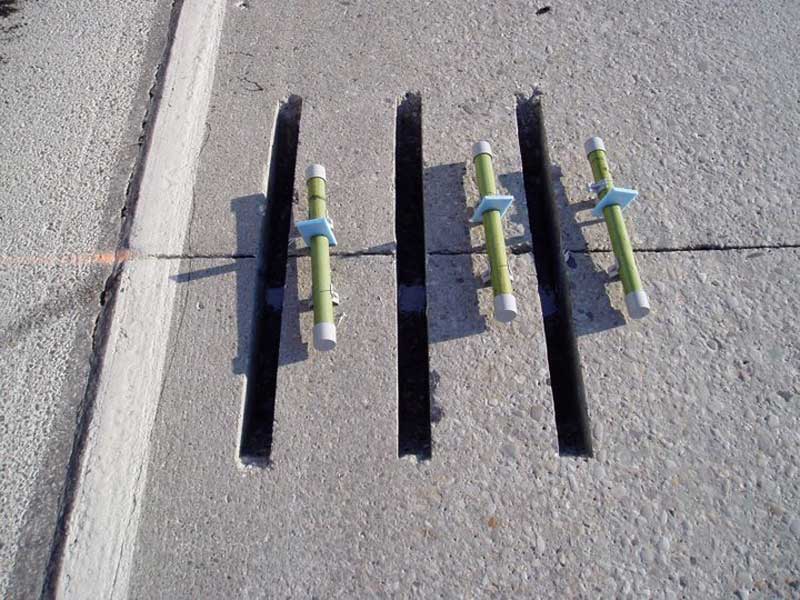Dowel Bar Size
Regardless of type, dowel bars are 1.5 inches in diameter, 18 inches in length and placed at the mid slab depth spaced on 12-inch centers. If fiber reinforced polymer dowel bars are eventually approved they may be specified in diameters greater than 1.5 inches.
Application of Dowel Bar Type Selection
The conventional application practice for mainline 12-foot lanes is eleven bars spaced 12 inches apart with the first bar 12 inches from the pavement edge. Modification to this practice is allowed for lanes 3, 4 and 5 of multi-lane facilities (greater than two lanes in each direction), HOV lanes, and intersections. The modification is eight bars per joint (four in each wheel path) with the first and last bar located 12 inches from the lane edge. Dowel bar retrofits use three bars per wheel path with the outer bars located 18 inches from the pavement edges.
Overview
WSDOT has over 2,300 lane-miles of concrete pavements. Seventy-five percent of these pavements have exceeded their 20-year design life and have received over twice the traffic loading for which they were designed. In general, they have performed well. However, one-third of these pavements have some measure of faulting due to the loss of aggregate interlock at the transverse contraction joints. Dowel bars are being used to retrofit many of these older pavements which extend their life by more than 15 years. Dowel bars are also required in all new concrete pavements to ensure a 50-year service life. Dowel bars must stand up to repeated loadings from traffic and resist corrosion to be effective for this extended service life. This folio was developed to assist in selecting the best dowel bar for a project.
The Need for Dowel Bars
The majority of the concrete pavements built in the 1950’s through 1970’s were on interstate highways constructed as part of the Federal Aid Highway Act of 1956. Most of these pavements are still in service while receiving little or no rehabilitation (which has primarily been in the form of panel replacements, dowel bar retrofits and diamond grinding) while carrying anywhere from two to five times the originally estimated traffic volumes. This longevity reflects well upon the structural capacity of these pavements but may also be a reflection of an original design that was overly conservative for the estimated 20-year design life.
The design for these pavements was 8 inches of concrete over 6 inches of clean granular material. For “large volume roadways” in wetter climate areas, the concrete thickness was increased to 9 inches while keeping the same 6 inches of clean granular base. In some cases an asphalt treated base was placed beneath the concrete slab.
The older pavements did not use dowels but relied on aggregate interlock to prevent movement of adjacent panels. Unfortunately, over time the aggregate interlocking of the slabs failed resulting in faulting. The decision to forgo dowels was based largely on the potential for the plain steel dowel bars used at the time to corrode and lock up the joint. Locked joints were viewed as more detrimental to performance than faulting.
A combination of the 1993 AASHTO Guide for the Design of Pavement Structures and the Mechanistic Empirical Design Guide (MEPDG) is currently used to design the thickness of concrete pavements. Pavement designs are based on the expected traffic loading over a 50-year design life which results in thicknesses of 11 to 13 inches on interstate routes. This includes an additional inch to accommodate future diamond grinding to remove wear from studded tires. Dowel bars are required at all transverse joints.
Dowel bar retrofitting began in 1992 with the construction of the first test section on I-90 near Snoqualmie Pass. Since that date approximately 571 lane miles have been retrofitted. Retrofitting involves cutting slots in the pavement at each transverse joint; placing dowel bars at mid slab height in the slots; backfilling the slots with concrete patching material and then diamond grinding the pavement to remove the faulting.
Dowel Bar Selection Protocol
Since dowel bars must last the entire life of the surrounding concrete pavement, a protocol was developed for the selection of the appropriate dowel bar type based on the risk of corrosion. Corrosion risk is dependent on the moisture and deicing compound exposure, which varies across the state. Western Washington pavements, in general, have the greatest exposure to moisture, while most of Eastern Washington is considerably drier, experiencing more snow but less rainfall. Mountain passes, particularly those with “clear pavement” protocols (highways maintained in a snow/ice free condition) are exposed to higher amounts of corrosive salts and other deicing treatments during winter months. All Interstate routes which include Snoqualmie Pass are “clear pavement” roadways.
Dowel Bar Cost versus Corrosion Resistance
Corrosion resistance of the dowels increases as does cost when moving from uncoated black steel to the most corrosion resistant solid stainless steel. Additionally, there is a direct link between cost and risk: less risk – higher cost, lower cost – higher risk of corrosion before 50 years.
Dowel Bar Alternatives
There are three types of dowel bars currently allowed; (1) stainless steel alternatives, (2) corrosion resistant steel alternatives, and (3) epoxy coated alternatives. The stainless steel alternatives include solid stainless steel bars, ordinary steel bars surrounded by a stainless steel cladding, and stainless steel sleeves with an epoxy coated dowel bar insert. The corrosion resistant alternatives include MMFX
2 steel bars which are high chromium content bars just below the threshold of being classified as stainless steel. The other corrosion resistant alternative is zinc coated black steel bars. Epoxy coated dowel bars must meet ASTM A934 epoxy coating requirements. The purple ASTM A934 epoxy coating is a more damage resistant epoxy coating than the previously used green ASTM M284 coating. Uncoated plain steel dowel bars are not allowed in any application. Non-metallic fiber reinforced polymer (FRP) dowel bars are currently being evaluated to determine their performance in pavements exposure to heavy loadings from traffic.
http://www.wsdot.wa.gov/NR/rdonlyre...29826132144/0/DowelBarsfolio_Feb2013Final.pdf
Load Transfer info
http://metiebar.acpa.org/Concrete_Pavement/Technical/Fundamentals/Load_Transfer.asp




